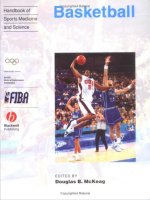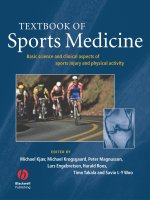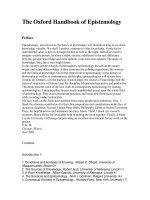- Trang chủ >>
- Khoa Học Tự Nhiên >>
- Vật lý
oxford american handbook of sports medicine apr 2010
Bạn đang xem bản rút gọn của tài liệu. Xem và tải ngay bản đầy đủ của tài liệu tại đây (5.55 MB, 839 trang )
About the Oxford American Handbooks in Medicine
The Oxford American Handbooks are fl exi-covered pocket clinical books,
providing practical guidance in quick reference, note form. Titles cover
major medical specialties or cross-specialty topics and are aimed at stu-
dents, residents, internists, family physicians, and practicing physicians
within specifi c disciplines.
Their reputation is built on including the best clinical information, com-
plemented by hints, tips, and advice from the authors. Each one is carefully
reviewed by senior subject experts, residents, and students to ensure that
content refl ects the reality of day-to-day medical practice.
Key series features
Written in short chunks, each topic is covered in a two-page spread •
to enable readers to fi nd information quickly. They are also perfect
for test preparation and gaining a quick overview of a subject without
scanning through unnecessary pages.
Content is evidence based and complemented by the expertise and
•
judgment of experienced authors.
The Handbooks provide a humanistic approach to medicine—it’s more •
than just treatment by numbers.
A “friend in your pocket,” the Handbooks offer honest, reliable
•
guidance about the diffi culties of practicing medicine and provide
coverage of both the practice and art of medicine.
For quick reference, useful “everyday” information is included on the
•
inside covers.
Made with hard-wearing plastic covers, tough paper, and built-in ribbon
•
bookmarks, the Handbooks stand up to heavy usage.
This page intentionally left blank
Oxford American Handbook of
Sports Medicine
Published and Forthcoming Oxford American Handbooks
Oxford American Handbook of Clinical Medicine
Oxford American Handbook of Anesthesiology
Oxford American Handbook of Clinical Dentistry
Oxford American Handbook of Clinical Diagnosis
Oxford American Handbook of Clinical Pharmacy
Oxford American Handbook of Critical Care
Oxford American Handbook of Emergency Medicine
Oxford American Handbook of Geriatric Medicine
Oxford American Handbook of Nephrology and Hypertension
Oxford American Handbook of Obstetrics and Gynecology
Oxford American Handbook of Oncology
Oxford American Handbook of Otolaryngology
Oxford American Handbook of Pediatrics
Oxford American Handbook of Physical Medicine and Rehabilitation
Oxford American Handbook of Psychiatry
Oxford American Handbook of Pulmonary Medicine
Oxford American Handbook of Rheumatology
Oxford American Handbook of Surgery
1
Oxford American
Handbook of
Sports
Medicine
Edited by
Jeffrey R. Bytomski
Head Medical Team Physician
Associate Professor and Director
Primary Care Sports Medicine Fellowship
Duke University Medical Center
Durham, North Carolina
Claude T. Moorman, III
Associate Professor
Head Team Physician and Director
Duke Sports Medicine
Duke University Medical Center
Durham, North Carolina
with
Domhnall MacAuley
School of Life and Health Science
University of Ulster
Department of Epidemiology
The Queen’s University of Belfast
Northern Ireland
3
Oxford University Press, Inc. publishes works that further
Oxford University’s objective of excellence
in research, scholarship and education.
Oxford New York
Auckland Cape Town Dar es Salaam Hong Kong Karachi
Kuala Lumpur Madrid Melbourne Mexico City Nairobi
New Delhi Shanghai Taipei Toronto
With offi ces in
Argentina Austria Brazil Chile Czech Republic France Greece
Guatemala Hungary Italy Japan Poland Portugal
Singapore South Korea Switzerland Thailand Turkey Ukraine Vietnam
Copyright © 2010 by Oxford University Press, Inc.
Published by Oxford University Press Inc.
198 Madison Avenue, New York, New York 10016
www.oup.com
Oxford is a registered trade mark of Oxford University Press
First published 2010
All rights reserved. No part of this publication may be reproduced,
stored in a retrieval system, or transmitted, in any form or by any means,
electronic, mechanical, photocopying, recording, or otherwise,
without the prior permission of Oxford University Press,
Library of Congress Cataloging-in-Publication Data
Oxford American handbook of sports medicine / edited by Jeffrey R. Bytomski,
Claude T. Moorman with Domhnall MacAuley.
p. ; cm. — (Oxford American handbooks)
Adapted from: Oxford handbook of sport and exercise medicine / edited by
Domhnall MacAuley. 2007.
Includes bibliographical references and index.
ISBN 978–0–19–537219–9
1. Sports medicine—Handbooks, manuals, etc. I. Bytomski, Jeffrey R. II. Moorman,
Claude T. III. MacAuley, Domhnall. IV. Title: Handbook of sports medicine.
V. Series: Oxford American handbooks. [DNLM: 1. Sports Medicine—Handbooks.
2. Athletic Injuries—Handbooks. QT 29 O97 2010]
RC1211.O938 2010
613.71—dc22 2009023186
9 8 7 6 5 4 3 2 1
Printed in China
on acid-free paper
This material is not intended to be, and should not be considered,
a substitute for medical or other professional advice. Treatment for
the conditions described in this material is highly dependent on the indi-
vidual circumstances. And, while this material is designed to offer accurate
information with respect to the subject matter covered and to be current
as of the time it was written, research and knowledge about medical and
health issues is constantly evolving and dose schedules for medications are
being revised continua lly, with new side effects recognized and accounted
for regularly. Readers must therefore always check the product informa-
tion and clinical procedures with the most up-to-date published product
information and data sheets provided by the manufacturers and the most
recent codes of conduct and safety regulation. Oxford University Press and
the authors make no representations or warranties to readers, express
or implied, as to the accuracy or completeness of this material, including
without limitation that they make no representation or warranties as to
the accuracy or effi cacy of the drug dosages mentioned in the material.
The authors and the publishers do not accept, and expressly disclaim, any
responsibility for any liability, loss or risk that may be claimed or incurred
as a consequence of the use and/or application of any of the contents of
this material.
This page intentionally left blank
Preface
vii
Preface
The world of sports medicine is becoming more complex as athletes receive
care from a multi-faceted team including physicians, athletic trainers, physical
therapists, and sports psychologists, to name a few. Many other professions
assist in the care of athletes as well. Sports medicine is unique in balancing
a safe return to sports while aggressively treating the problem in the least
amount of time. With extensive media coverage of elite athletes, every athlete
from children to the average “weekend warrior” expect the same level of care
given to their sports elite fi gures. The sports medicine team is stretched on a
daily basis to provide cutting-edge care while maintaining a full schedule.
The purpose of this Handbook is to have a reliable source readily available
to those who are on the frontlines of sports medicine care. It is meant to be
a reference as care providers travel from the offi ce, to the training room, to
the sideline, and around the world. Our aim for this text is to bridge the gap
between comprehensive knowledge and quick access at the point of care by
multiple levels of providers. This book is adapted from the original British
version and has the advantage of knowledge collected from many experts
around the globe. We have provided some practical chapters on procedures
and radiology as well as exposure to many of the techniques used in the
evolving world of sports psychology. The scope of the text ranges from
discussion of event coverage and preparticipation exams to both acute and
chronic treatment of common medical and orthopedic problems in athletes.
We hope you gain the knowledge and insight needed to take care of
your athletes at the highest level, wherever your travels take you.
Acknowledgments
This Handbook has only come together through the time, effort, and sacri-
fi ce of many individuals, not unlike the sports medicine team caring for its
athletes at the highest level. The authors did a wonderful job of reviewing
the previous text while updating and molding the new chapters to their
current version. The clinical experience and knowledge of Dr. Moorman
was without equal in assuring a quality text in the orthopedic chapters. Also,
Andrea Seils at Oxford University Press has been instrumental in making
this publication a high-quality Handbook. I would also like to thank all of the
families of the contributors for their sacrifi ce in allowing the contributors to
take time away from their schedules to make this a fi ne Handbook.
And fi nally, I would like to thank Shanda, Jarek, Trevor, and Alexandra for
their patience and sacrifi ce as I spent time away from them in preparing the
Handbook you have in front of you.
Jeffrey R. Bytomski
This page intentionally left blank
Contents
ix
Detailed contents xi
List of color plates xxvi
Contributors xxvii
Symbols and abbreviations xxxi
1 Acute care and sports injury
1
2 Head and face
53
3 Shoulder
97
4 Elbow and forearm
137
5 Wrist and hand
163
6 Spine
199
7 Hip and pelvis
225
8 Knee
273
9 Ankle and lower leg
307
10 Foot
335
11 Medical issues in athletes
363
12 Cardiovascular
405
13 Gastroenterology and genitourinary
441
14 Infectious diseases
457
15 Rheumatology
469
16 Dermatology
493
17 The female athlete
519
18 Ergogenic aids
543
19 Physical therapy and rehabilitation
563
CONTENTS
x
20 Radiology
587
21 Sports psychology
653
22 The team physician
671
23 Procedures
707
Index 783
xi
Detailed contents
1 Acute care and sports injury 1
Sports fi rst aid 2
Basic life support 4
Resuscitation of children 8
Advanced cardiac life support 10
Automated external defi brillators 16
Major emergencies in sport 18
The unconscious athlete 19
Choking 20
Management of shock and bleeding 22
Injury management 24
General management plan for acute sports
injuries 26
Management of acute soft tissue injury 28
Care of wounds 32
Nonsteroidal anti-infl ammatory drugs
(NSAIDs) 36
Strains and sprains 40
Ligaments 42
Bone 46
Sports injury in children 50
2 Head and face 53
Traumatic brain injury (TBI) 54
Glasgow Coma Scale (GCS) 55
Management of traumatic brain injury 56
Traumatic intracerebral hematomas and
contusion 59
Subdural hematoma 60
Epidural hematoma 61
Traumatic subarachnoid hemorrhage 62
Diffuse cerebral swelling 63
Head injury advice card 64
xii
DETAILED CONTENTS
Sports concussion 66
Acute concussion management 68
The SCAT2 (Sport Concussion Assessment
Tool 2) 70
Return to play 74
Neuroimaging 76
Concussion grading scales 78
Concussion complications 78
Concussion prevention 80
Concussion and the preparticipation
exam 81
Pediatric concussions 81
Post-traumatic headache 82
Headaches and sport 84
Epilepsy and sports 88
Fractures 90
Eye injuries 91
Boxing and head injury 92
Paradoxical vocal cord motion (PVCM) or
vocal cord dysfunction (VCD) 94
Dental injuries 95
External ear injuries 96
3 Shoulder 97
Anatomy 98
History 104
Examination 106
Special tests 108
Nerves 112
Shoulder disorders 113
Acute traumatic causes 114
Nonoperative management of shoulder
dislocation 117
Rehabilitation 118
Acromioclavicular joint sprains and
dislocations 120
xiii
DETAILED CONTENTS
Sternoclavicular joint sprains and
dislocations 121
Glenoid labrum tears 122
Biceps tendon rupture 124
Fractures of the shoulder 125
Chronic overuse disorders 126
Atraumatic causes 134
4 Elbow and forearm 137
History 138
Examination 140
Special tests 142
Medial epicondylosis (golfer’s elbow) 143
Medial epicondylar apophysitis 144
Ulnar collateral ligament injury 145
Osteochondritis dissecans and
osteochondrosis 146
Lateral epicondylosis (tennis elbow) 148
Posterolateral rotatory instability 150
Acute injuries 152
Chronic elbow injuries 156
5 Wrist and hand 163
Epidemiology 164
Wrist biomechanics 166
Fracture of the distal radius 168
Fracture of the scaphoid 170
Fracture of the hamate 172
Fracture of the pisiform 173
Fracture of the fi fth metacarpal neck (boxer’s
fracture) 174
Fracture–dislocation of the fi rst metacarpal base
(Bennett’s or Rolando’s fracture) 176
Phalangeal shaft fractures 177
Dislocation of the carpal bones 178
xiv
DETAILED CONTENTS
Dislocation of the metacarpophalangeal (MCP)
joints 180
Dislocation of the interphalangeal (IP) joints 181
Mallet fi nger 182
Jersey fi nger 183
Boutonniere deformity 184
Sagittal band rupture (boxer’s knuckle) 185
Ulnar collateral ligament injuries of the thumb
MCP joint (skier’s thumb) 186
Other collateral ligament injuries 188
Carpal tunnel syndrome 189
Ulnar nerve compression 190
Other nerve injury syndromes 190
De Quervain’s tenosynovitis 191
Other tendinopathies 192
Ganglion 193
Impaction syndromes 193
Radial epiphysitis (gymnast’s wrist) 194
Triangular fi brocartilage complex (TFCC)
tears 195
Kienbock’s disease 196
6 Spine 199
History 200
Examination 202
Special tests 206
Diagnosis 208
Acute spinal injury 211
Acute injuries of the back in sports 212
Management of musculoligamentous injuries
of the back 213
Disc disease 214
Pars interarticularis and spondylolysis 218
Spondylolisthesis 220
Scheuermann’s disease 223
Sacroiliac joint 224
xv
DETAILED CONTENTS
7 Hip and pelvis 225
Examination of the hip 226
Special tests 232
Femur: acute injury 233
Growth plate injury 234
Femoral neck stress fracture 236
Trochanteric bursitis 238
Iliotibial band friction syndrome 239
Thigh contusion 240
Myositis ossifi cans 242
Osteoarthritis (OA) of the hip 244
Osteitis pubis 246
Sports hernia (Gilmore’s groin) 248
Groin pain 250
Avulsions around the ilium 252
Piriformis syndrome 254
Snapping hip syndrome 256
Hamstring injury 258
Obturator nerve entrapment 261
Dislocation and subluxation of the hip joint 262
Femoroacetabular impingement (FAI) 263
Stress fractures of the pubic rami 264
Calcifi c tendinopathy of the hip 264
Acetabular labral tears 265
Ischial (ischiogluteal) bursitis 265
Sacroiliac joint (SIJ) disorders 266
Injuries in children 268
8 Knee 273
History 274
Examination 276
Special tests 280
Diagnosis of knee injuries 281
Medial collateral ligament (MCL) 282
xvi
DETAILED CONTENTS
Rehabilitation after medial collateral ligament
sprain 284
Lateral collateral ligament (LCL) 289
Anterior cruciate ligament (ACL) 290
Posterior cruciate ligament (PCL) 292
Meniscal injuries 293
Articular cartilage injury 294
Anterior knee pain 295
Patellar dislocation 296
Hoffa’s syndrome 296
Iliotibial band friction syndrome (ITBFS) 297
Patellofemoral pain (syndrome) 298
Patellar tendinopathy 300
Osgood–Schlatter disease 301
Sinding–Larsen–Johannson disease (“jumper’s
knee”) 302
Juvenile osteochondritis dissecans 303
Bipartite patella and patellofemoral pain
syndrome 304
Discoid lateral meniscus 305
9 Ankle and lower leg 307
Examination of the ankle 308
Special tests 311
Functional tests 311
Persistent painful ankle 312
Acute ankle sprain 314
Rehabilitation after ankle sprain (grade 2) 316
Medial ligament injuries 318
Syndesmosis sprain 318
Fractures 318
Lateral ankle pain 320
Medial ankle pain 322
Anterior ankle pain 324
Posterior ankle pain 325
xvii
DETAILED CONTENTS
Shin splints 326
Achilles tendinopathy 328
Achilles tendon rupture 329
Retrocalcaneal bursitis 330
Chronic exertional leg pain 330
Anterior compartment syndrome 331
Posterior compartment syndrome 332
Popliteal artery entrapment 333
10 Foot 335
Fracture of the calcaneus 336
Fracture of the metatarsal bones 337
Lisfranc fracture: dislocations 338
Fat pad contusion 338
Midtarsal joint sprains 339
Turf toe 339
Hallux rigidus (“footballer’s toe”) 340
Normal walking 341
Pronation 342
Supination 342
Footwear 343
Gait analysis 344
Plantar fasciitis 346
Extensor tendinopathy 348
Stress fractures of the calcaneus 348
Stress fractures of the navicular 349
Stress fractures of the metatarsals 350
Jones fracture 351
Metatarsalgia 352
Morton’s (interdigital) neuroma 353
Sesamoid injury 354
Cuboid syndrome 355
Os naviculare syndrome 355
xviii
DETAILED CONTENTS
Sever’s disease (traction apophysitis
calcaneum) 356
Iselin’s disease (traction apophysitis affecting base
of fi fth metatarsal) 357
Traction apophysitis navicular (insertion tibialis
posterior tendon) 357
Tarsal coalition 358
Freiberg’s disease 359
Kohler’s disease 360
Subungual hematoma 361
Ingrown toenails (onychocryptosis) 361
11 Medical issues in athletes 363
Physiology in exercise
What happens when we exercise? 364
Basic principles of training 365
Fitness deterioration with aging 366
Overtraining syndrome 368
Pulmonary issues
Exercise-induced bronchospasm 370
Hematology
Iron defi ciency anemia 376
Sickle cell anemia 378
Endocrine issues
Diabetes mellitus 380
Nutrition
Body weight 384
Energy requirements 385
Food and exercise 386
Recovery after exercise 390
Environmental concerns
Exercise and the environment 392
Exercise at altitude 400
xix
DETAILED CONTENTS
12 Cardiovascular 405
Preparticipation screening 406
Sudden cardiac death in athletes 408
Cardiovascular abnormalities in the setting of
athletic participation 410
Hypertrophic cardiomyopathy 413
Other congenital defects 414
Congenital coronary artery anomalies 417
Kawasaki disease 417
Valvular disorders 418
Arrhythmias 422
QT syndromes 426
Brugada syndrome 427
Marfan syndrome 428
Other cardiomyopathies 432
Ehlers–Danlos syndrome 433
Coronary artery anomalies 433
Coronary artery disease 434
Commotio cordis 435
The athlete’s heart 435
Evaluation of the symptomatic athlete 436
Classifi cation of sports 437
Automated external defi brillators 438
Exercise prescription 439
13 Gastroenterology and genitourinary 441
Abdominal injury 442
Winded athlete 443
Rectus sheath hematoma 443
Splenic rupture 444
Liver damage 444
Pancreatic damage 445
Bowel rupture 445
Pancreatitis 446
Appendicitis 446
xx
DETAILED CONTENTS
Diarrhea (“runner’s trots”) 447
Gastroesophageal refl ux disease (GERD, or
heartburn) 447
Renal trauma 448
Ureteric avulsion 450
Bladder rupture 450
Urethral rupture 450
Injuries of the scrotum and testes 451
Testicular torsion 451
Testicular cancer 451
Renal physiology and exercise 452
14 Infectious diseases 457
Effects of exercise on immunity 458
Why are athletes prone to infection? 459
Upper respiratory infections (URIs) 460
Common infections 461
Community-acquired methicillin-resistant
Staphylococcus aureus (CA-MRSA) 462
Infectious mononucleosis 463
Flu-like infections 464
Viral hepatitis 465
Human immunodefi ciency virus (HIV) 466
Travelers’ diarrhea 467
15 Rheumatology 469
Arthritis overview 470
Osteoarthritis 472
Crystal arthropathy 476
Rheumatoid arthritis 480
Seronegative spondyloarthropathies 484
Infectious arthritis 486
Other arthritis-related conditions 490
xxi
DETAILED CONTENTS
16 Dermatology 493
Problems related to skin trauma 494
Problems related to environmental
exposure 498
Fungal infections 502
Bacterial infections 506
Viral infections 510
Common causes of dermatitis 514
Description of terms in dermatology 516
17 The female athlete 519
Gender and performance 520
Menstrual cycle 522
Menarche 524
Primary amenorrhea 525
Menstrual irregularities 526
Progression of exercise-related menstrual
changes 527
Secondary amenorrhea 527
Treatment of menstrual irregularities 527
Dysmenorrhea 528
Premenstrual syndrome 529
Contraception 530
Manipulation of the menstrual cycle 532
Female athlete triad 534
Pregnancy and exercise 536
Pelvic pain 540
Injuries 541
18 Ergogenic aids 543
Ergogenic aids 544
Performance-enhancing drugs 546
Stimulants 550
xxii
DETAILED CONTENTS
Dietary ergogenic aids 554
Prohibited drugs 558
Drug testing 560
Future concerns 561
19 Physical therapy and rehabilitation 563
Physical therapy 564
Principles of rehabilitation 566
Physical therapy examination and screening 568
Therapeutic modalities 570
Manual therapy 572
Stretching 574
Balance and proprioception 576
Muscle performance 578
Plyometrics 582
Sports-specifi c fi tness tests and training 584
Orthotics 586
20 Radiology 587
Imaging modalities 588
General pathology 590
Hip and pelvis 602
Knee 608
Lower leg and ankle 614
Foot 616
Shoulder 620
Elbow 626
Wrist and hand 630
Head and spine 636
Pediatric imaging 644
21 Sports psychology 653
Introduction 654
Motivation and sports performance 656









